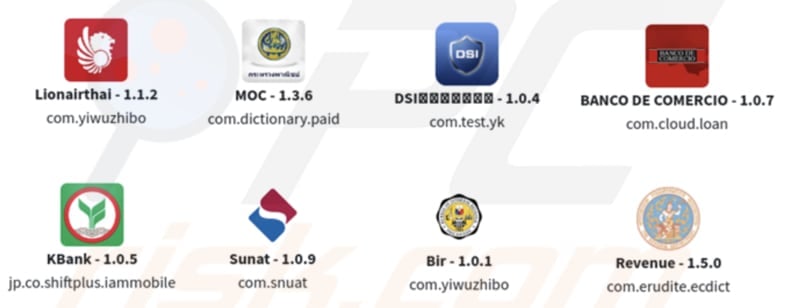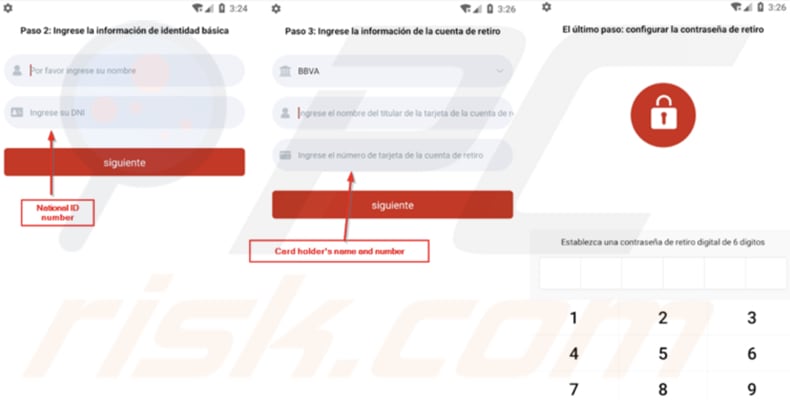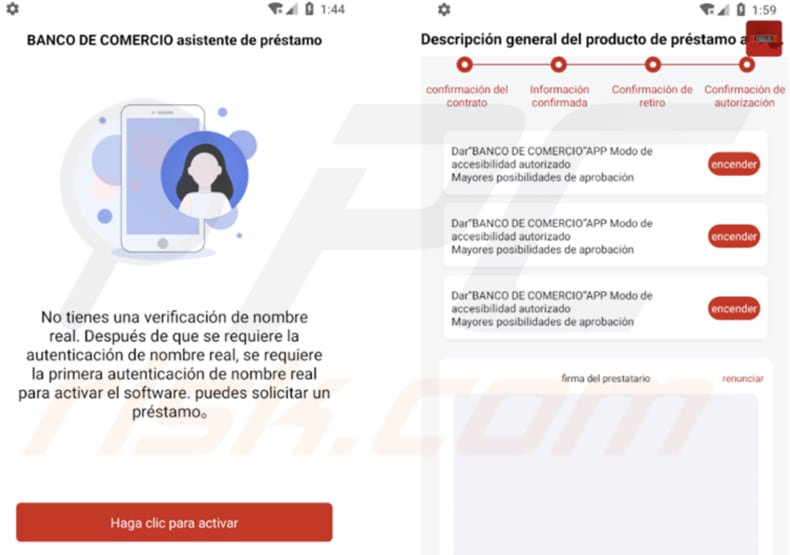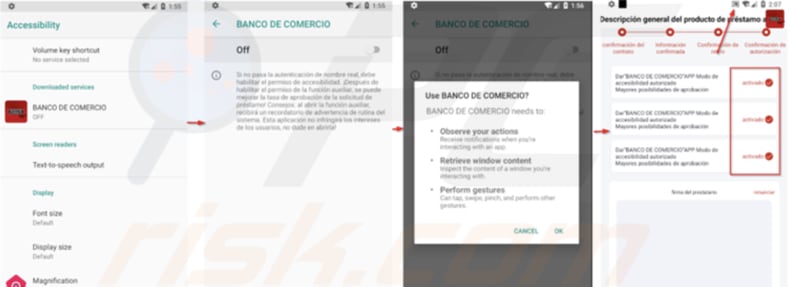Get free scan and check if your device is infected.
Remove it nowTo use full-featured product, you have to purchase a license for Combo Cleaner. Seven days free trial available. Combo Cleaner is owned and operated by RCS LT, the parent company of PCRisk.com.
What kind of malware is Gigabud?
Gigabud is the name of an Android Remote Access Trojan (RAT) Android that can record the victim's screen and steal banking credentials by abusing the Accessibility Service. Gigabud masquerades as banking, shopping, and other applications. Threat actors have been observed using deceptive websites to distribute Gigabud RAT.

More about Gigabud RAT
In 2022, Gigabud was distributed via fake Thai Airline – Thai Lion Air and Department of Special Investigation Thailand websites. It is known that Gigabud targeted users in Thailand. Later, threat actors started targeting users in Peru, the Philippines, and other countries.
Gigabud RAT masquerades as various government agencies, banks, and other entities. Examples of impersonated entities are Advice (an IT company in Thailand), Banco de Comercio (a Peruvian bank), BIR (Bureau of Internal Revenue in the Philippines), DSI (Department of Special Investigation of Thailand), Kasikornbank, Shopee, SUNAT, and Thai Lion Air.
Gigabud RAT shows fake login screens to trick users into providing login information (e.g., IDs, usernames, mobile numbers, passwords). Fake login screens displayed by Gigabud mimic the user interface of legitimate banking or other applications. Gigabud RAT sends entered information to a Command and Control server.
Also, Gigabud RAT shows fake registration forms to lure victims into providing ID card information, credit card details, and other requested information. After the victim logs in or registers via the malicious app, Gigabud RAT collects info about apps installed on infected devices.
At the final stage, Gigabud RAT requests accessibility permissions allowing it to record the victim's screen and display content over other apps. Once Gigabud RAT has those permissions, it connects to a C2 server to receive commands enabling it to steal targeted bank details, send text messages from the infected device, open targeted apps, and more.
Gigabud RAT displays fake dialog boxes accordingly to targeted applications. It shows fake windows over targeted legitimate apps to steal sensitive information.
| Name | Gigabud malware |
| Threat Type | Android malware, malicious application, unwanted application. |
| Detection Names | N/A (VirusTotal) |
| Symptoms | Trojans are designed to stealthily infiltrate the victim's device and remain silent, and thus no particular symptoms are clearly visible on an infected device. |
| Distribution methods | Deceptive websites and applications |
| Damage | Stolen personal information (private messages, logins/passwords, etc.), decreased device performance, battery is drained quickly, decreased Internet speed, huge data losses, monetary losses, stolen identity. |
| Malware Removal (Windows) |
To eliminate possible malware infections, scan your computer with legitimate antivirus software. Our security researchers recommend using Combo Cleaner. Download Combo CleanerTo use full-featured product, you have to purchase a license for Combo Cleaner. 7 days free trial available. Combo Cleaner is owned and operated by RCS LT, the parent company of PCRisk.com. |
Similar Trojans in general
RATs targeting sensitive data are used to steal login credentials, credit card details, 2FA codes, and other sensitive information. Threat actors use the obtained information to steal money, identities, online accounts, etc. In most cases, they use the extracted data for financial gain.
Examples of other Android RATs are Ahmyth, Cypher, and 888.
How did Gigabud infiltrate my device?
Gigabud is distributed via fake/deceptive websites disguised as official pages (e.g., Thai Airline – Thai Lion Air and Department of Special Investigation Thailand websites). Users infect devices with Gigabud after installing trojanized apps mimicking legitimate banking, shopping, or other applications.
How to avoid installation of malware?
Read reviews before downloading applications. Download them from official websites or Google Play Store only. Do not trust ads on questionable websites. Be wary of opening links received via SMS messages and email. Keep Google Play Protect enabled at all times.
Use reputed antivirus software. Keep the operating system and installed apps updated.
Examples of apps used as a disguise (source: cyble.com):

Gigabud requesting for credit card details during registration (source: cyble.com):

Fake load approval displayed by Gigabud RAT (source: cyble.com):

Gigabud RAT shows a fake authentication page and asks for permissions (source: cyble.com):

Gigabud RAT abuses Accessibility to enable screen recording (source: cyble.com):

Quick menu:
- Introduction
- How to delete browsing history from the Chrome web browser?
- How to disable browser notifications in the Chrome web browser?
- How to reset the Chrome web browser?
- How to delete browsing history from the Firefox web browser?
- How to disable browser notifications in the Firefox web browser?
- How to reset the Firefox web browser?
- How to uninstall potentially unwanted and/or malicious applications?
- How to boot the Android device in "Safe Mode"?
- How to check the battery usage of various applications?
- How to check the data usage of various applications?
- How to install the latest software updates?
- How to reset the system to its default state?
- How to disable applications that have administrator privileges?
Delete browsing history from the Chrome web browser:

Tap the "Menu" button (three dots on the right-upper corner of the screen) and select "History" in the opened dropdown menu.

Tap "Clear browsing data", select "ADVANCED" tab, choose the time range and data types you want to delete and tap "Clear data".
Disable browser notifications in the Chrome web browser:

Tap the "Menu" button (three dots on the right-upper corner of the screen) and select "Settings" in the opened dropdown menu.

Scroll down until you see "Site settings" option and tap it. Scroll down until you see "Notifications" option and tap it.

Find the websites that deliver browser notifications, tap on them and click "Clear & reset". This will remove permissions granted for these websites to deliver notifications. However, once you visit the same site again, it may ask for a permission again. You can choose whether to give these permissions or not (if you choose to decline the website will go to "Blocked" section and will no longer ask you for the permission).
Reset the Chrome web browser:

Go to "Settings", scroll down until you see "Apps" and tap it.

Scroll down until you find "Chrome" application, select it and tap "Storage" option.

Tap "MANAGE STORAGE", then "CLEAR ALL DATA" and confirm the action by taping "OK". Note that resetting the browser will eliminate all data stored within. This means that all saved logins/passwords, browsing history, non-default settings and other data will be deleted. You will also have to re-login into all websites as well.
Delete browsing history from the Firefox web browser:

Tap the "Menu" button (three dots on the right-upper corner of the screen) and select "History" in the opened dropdown menu.

Scroll down until you see "Clear private data" and tap it. Select data types you want to remove and tap "CLEAR DATA".
Disable browser notifications in the Firefox web browser:

Visit the website that is delivering browser notifications, tap the icon displayed on the left of URL bar (the icon will not necessarily be a "Lock") and select "Edit Site Settings".

In the opened pop-up opt-in the "Notifications" option and tap "CLEAR".
Reset the Firefox web browser:

Go to "Settings", scroll down until you see "Apps" and tap it.

Scroll down until you find "Firefox" application, select it and tap "Storage" option.

Tap "CLEAR DATA" and confirm the action by taping "DELETE". Note that resetting the browser will eliminate all data stored within. This means that all saved logins/passwords, browsing history, non-default settings and other data will be deleted. You will also have to re-login into all websites as well.
Uninstall potentially unwanted and/or malicious applications:

Go to "Settings", scroll down until you see "Apps" and tap it.

Scroll down until you see a potentially unwanted and/or malicious application, select it and tap "Uninstall". If, for some reason, you are unable to remove the selected app (e.g., you are prompted with an error message), you should try using the "Safe Mode".
Boot the Android device in "Safe Mode":
The "Safe Mode" in Android operating system temporarily disables all third-party applications from running. Using this mode is a good way to diagnose and solve various issues (e.g., remove malicious applications that prevent users you from doing so when the device is running "normally").

Push the "Power" button and hold it until you see the "Power off" screen. Tap the "Power off" icon and hold it. After a few seconds the "Safe Mode" option will appear and you'll be able run it by restarting the device.
Check the battery usage of various applications:

Go to "Settings", scroll down until you see "Device maintenance" and tap it.

Tap "Battery" and check the usage of each application. Legitimate/genuine applications are designed to use as low energy as possible in order to provide the best user experience and to save power. Therefore, high battery usage may indicate that the application is malicious.
Check the data usage of various applications:

Go to "Settings", scroll down until you see "Connections" and tap it.

Scroll down until you see "Data usage" and select this option. As with battery, legitimate/genuine applications are designed to minimize data usage as much as possible. This means that huge data usage may indicate presence of malicious application. Note that some malicious applications might be designed to operate when the device is connected to wireless network only. For this reason, you should check both Mobile and Wi-Fi data usage.

If you find an application that uses a lot of data even though you never use it, then we strongly advise you to uninstall it as soon as possible.
Install the latest software updates:
Keeping the software up-to-date is a good practice when it comes to device safety. The device manufacturers are continually releasing various security patches and Android updates in order to fix errors and bugs that can be abused by cyber criminals. An outdated system is way more vulnerable, which is why you should always be sure that your device's software is up-to-date.

Go to "Settings", scroll down until you see "Software update" and tap it.

Tap "Download updates manually" and check if there are any updates available. If so, install them immediately. We also recommend to enable the "Download updates automatically" option - it will enable the system to notify you once an update is released and/or install it automatically.
Reset the system to its default state:
Performing a "Factory Reset" is a good way to remove all unwanted applications, restore system's settings to default and clean the device in general. However, you must keep in mind that all data within the device will be deleted, including photos, video/audio files, phone numbers (stored within the device, not the SIM card), SMS messages, and so forth. In other words, the device will be restored to its primal state.
You can also restore the basic system settings and/or simply network settings as well.

Go to "Settings", scroll down until you see "About phone" and tap it.

Scroll down until you see "Reset" and tap it. Now choose the action you want to perform:
"Reset settings" - restore all system settings to default;
"Reset network settings" - restore all network-related settings to default;
"Factory data reset" - reset the entire system and completely delete all stored data;
Disable applications that have administrator privileges:
If a malicious application gets administrator-level privileges it can seriously damage the system. To keep the device as safe as possible you should always check what apps have such privileges and disable the ones that shouldn't.

Go to "Settings", scroll down until you see "Lock screen and security" and tap it.

Scroll down until you see "Other security settings", tap it and then tap "Device admin apps".

Identify applications that should not have administrator privileges, tap them and then tap "DEACTIVATE".
Frequently Asked Questions (FAQ)
What are the biggest issues that malware can cause?
Malware can encrypt files, mine cryptocurrency, steal sensitive information, and perform other actions. It depends on the type of malware and its capabilities.
What is the purpose of Gigabud malware?
Gigabud RAT is used to steal sensitive information such as credit card details, login information, ID card information, mobile numbers, and more.
How did Gigabud malware infiltrate my device?
This malware is distributed via fake websites masquerading as official web pages. Users infect their Android devices by installing malicious apps downloaded from those pages.
Will Combo Cleaner protect me from malware?
Combo Cleaner will scan the operating system for threats and remove detected malware and other unwanted software. It can detect almost all known malware. It is recommended to use a full scan when willing to detect threats. Usually, high-end malware hides deep in the operating system.
Share:

Tomas Meskauskas
Expert security researcher, professional malware analyst
I am passionate about computer security and technology. I have an experience of over 10 years working in various companies related to computer technical issue solving and Internet security. I have been working as an author and editor for pcrisk.com since 2010. Follow me on Twitter and LinkedIn to stay informed about the latest online security threats.
PCrisk security portal is brought by a company RCS LT.
Joined forces of security researchers help educate computer users about the latest online security threats. More information about the company RCS LT.
Our malware removal guides are free. However, if you want to support us you can send us a donation.
DonatePCrisk security portal is brought by a company RCS LT.
Joined forces of security researchers help educate computer users about the latest online security threats. More information about the company RCS LT.
Our malware removal guides are free. However, if you want to support us you can send us a donation.
Donate
▼ Show Discussion